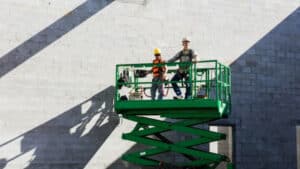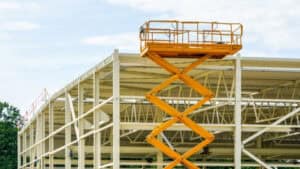
Scissor lifts have become indispensable machines in various industries, from construction and warehousing to facility maintenance and event management. These versatile machines provide a safe and efficient means to work at heights, enabling workers to reach elevated areas with ease. However, scissor lifts are not immune to technical issues and operational challenges.
IHURMO aims to explore the most common problems that operators and maintenance personnel encounter when working with scissor lifts. From hydraulic system failures to power source issues, control system malfunctions, and structural integrity concerns, we’ll delve into the root causes of these problems and provide practical solutions to address them.
What are the Common Technical Failures of Scissor Lifts
Hydraulic System Failures
During operation, operators may notice a sudden loss of lifting power, uneven lifting, or complete failure to raise or lower the platform.
In some cases, there might be visible hydraulic fluid leaks.
These problems typically stem from worn seals or hoses, contamination of hydraulic fluid, low fluid levels, or damage to hydraulic cylinders or pumps.
- Worn Seals or Hoses: Over time, these components can degrade, leading to leaks and pressure loss.
- Contaminated Hydraulic Fluid: Dirt, debris, or even water in the hydraulic fluid can cause significant damage to the system.
- Low Fluid Levels: Insufficient hydraulic fluid will prevent the system from functioning correctly.
- Damaged Cylinders or Pumps: These components are vital to the hydraulic system’s operation and can fail due to wear and tear or impact damage.
How to fix the problem?
First, check the hydraulic fluid levels and top up if necessary. Low fluid levels are a common cause of hydraulic problems.
Then, inspect the system for leaks, paying close attention to hoses, seals, and connections. Replace any damaged components immediately.
If air has entered the system, it may need to be bled. This should be done by a qualified technician, especially if the hydraulic cylinders are equipped with bleed screws. In cases of contaminated hydraulic fluid, the system should be flushed and refilled with clean fluid.
If these steps don’t resolve the issue, the hydraulic pump may be weak or failing and might need replacement.
Power Source Issues

Power source problems are another frequent concern. Operators may experience sudden power loss, difficulty starting the lift, or intermittent operation.
These issues often arise from depleted or faulty batteries, damaged charging systems, corroded battery terminals, or faulty alternators in engine-powered lifts.
How to fix the problem?
Start by checking the battery charge level. If low, recharge the batteries fully.
Then, check for any visible damage to battery cables or connections. Clean and tighten connections if necessary.
Control System Malfunctions

Control system malfunctions can significantly impact scissor lift operation. Operators might encounter unresponsive controls, erratic movement of the lift, or complete failure of the control panel.
These issues can result from damaged wiring or connections, worn-out control switches or joysticks, software glitches in computerized systems, or water intrusion causing electrical shorts.
- Wiring Woes: Damaged wiring or loose connections can disrupt communication between the controls and the lift mechanism.
- Worn-Out Controls: Control switches and joysticks can wear out over time, leading to unresponsive or erratic behavior.
- Software Glitches: Computerized control systems can experience software bugs that disrupt the operation.
- Water Damage: Moisture intrusion can cause electrical shorts and wreak havoc on control systems.
How to fix the problem?
Check for any fault codes on the control panel. These can provide valuable information about the specific problem and inspect the cord connecting the platform controls to the base. Ensure it’s securely connected and undamaged.
Look for any signs of water damage or corrosion in the control box. If found, the affected components may need replacement.
Structural Integrity Issues

While this problem is common, structural integrity issues are the most critical to address, as they can lead to dangerous and costly accidents. Signs of trouble include unusual noises, vibrations, instability during operation, or even visible deformation of the scissor arms or platform.
These problems often result from overloading the lift beyond its rated capacity, collisions or impacts, metal fatigue from prolonged use, or corrosion due to exposure to harsh environments.
- Overloading: Exceeding the lift’s rated load capacity places excessive stress on the structure.
- Collisions: Impacts can weaken or damage structural components.
- Metal Fatigue: Prolonged use can eventually lead to metal fatigue and failure.
- Corrosion: Exposure to harsh environments or inadequate maintenance can weaken the structure through corrosion.
How to fix the problem?
Conduct a thorough visual inspection of all structural components, including the scissor arms, platform, and base.
Check all welds and bolts for signs of stress or damage. Tighten any loose bolts and have any questionable welds inspected by a professional.
Inspect for any signs of corrosion or metal fatigue. Clean and treat any corroded areas and replace severely affected components.
What are the Safety Checks For a Scissor Lift?

Daily and Weekly Tasks
Performing daily and weekly tasks ensures the lift operates safely. Begin each day by removing debris from the platform. This minimizes safety hazards and allows for smooth operation.
Next, check that platform gates and chains are firmly secured and in good condition. Inspect the entire lift for any obvious damage or wear and address it immediately.
Ensure fluid levels, such as hydraulic oil, are within the recommended range. Lack of proper fluid level monitoring can lead to malfunction and increased wear on components. Make it a habit to log maintenance actions in your service and maintenance manual to track recurring issues.
Battery and Hydraulic System Care
Battery maintenance is crucial for electric scissor lifts. Monitor battery charge and usage daily. Track charging history to ensure batteries don’t deplete below unsafe levels, which could harm their longevity.
Clean battery terminals to prevent corrosion. Check hydraulic systems for leaks and maintain proper fluid levels. Regular hydraulic fluid checks and changes reduce wear and extend the lift’s life.
Log these actions to help identify patterns that might require attention. Proper attention to batteries and the hydraulic system can lead to reduced maintenance and replacement costs.
Frequently Asked Questions
What are common troubleshooting steps for an IHURMO scissor lift?
First, check the battery charge indicator lights in the control box to see if the battery level is adequate. Ensure the key is switched on and look for any fault codes. Inspect the cord to the control box for any damage. If necessary, replace the fuse located behind the engine tray.
Why might a used scissor lift fail to operate correctly?
A used scissor lift might malfunction due to water intrusion and corrosion. Rust on rails or corrosion on battery connectors are common. Examine the machine thoroughly for signs of water damage or corrosion, especially on electrical parts and connectors.
What safety concerns should be addressed with electrical scissor lifts?
Check all fluid levels, including oil, fuel, coolant, and hydraulics regularly. Inspect the machine thoroughly for leaks. Follow OSHA guidelines and reference the factory-issued manuals to ensure your machine is safe to operate.
How do you diagnose hydraulic issues in scissor lifts?
If the lifting platform is weak or unable to lift, first, ensure the load does not exceed the rated capacity. Next, check the power supply voltage to ensure it’s within the allowable range. Low voltage can prevent the motor from working properly.
What are the typical causes of a scissor lift failing to elevate?
A scissor lift might fail to elevate if it’s overloaded with weight beyond its rated capacity. Another reason could be low hydraulic fluid or power supply voltage issues.
What should you check when a scissor lift emits a clicking sound but doesn’t move?
If you hear a clicking sound and the lift doesn’t move, it might indicate a problem with the battery or the connections. Check the lift battery charge and ensure all connections are tight and free from corrosion.






